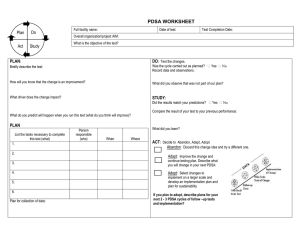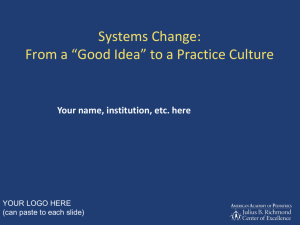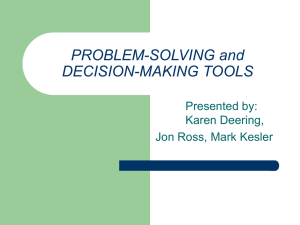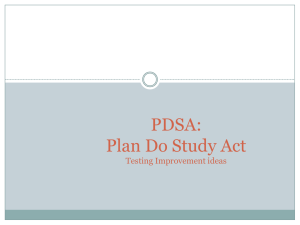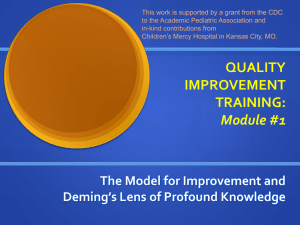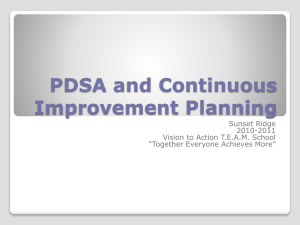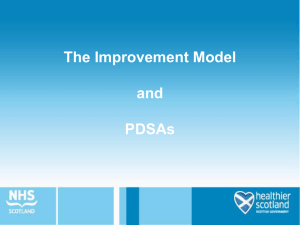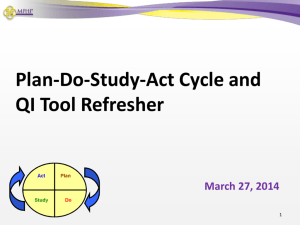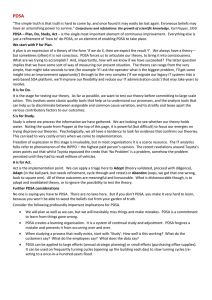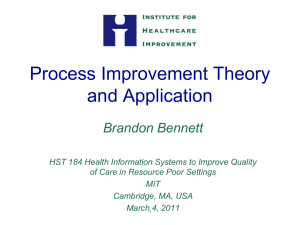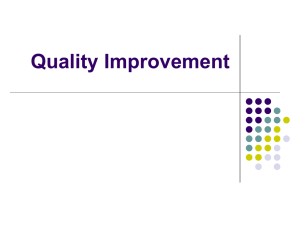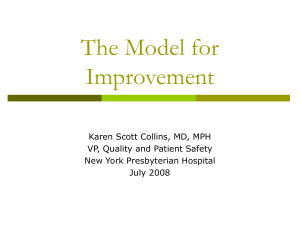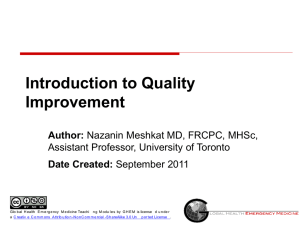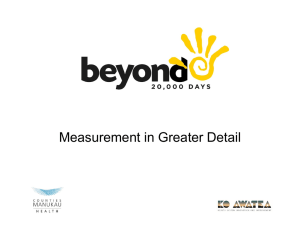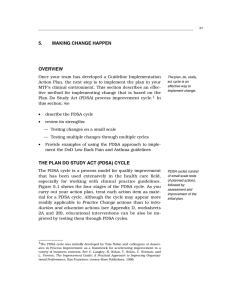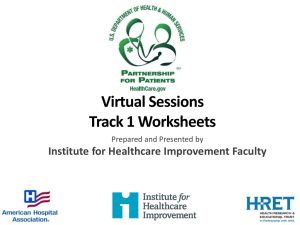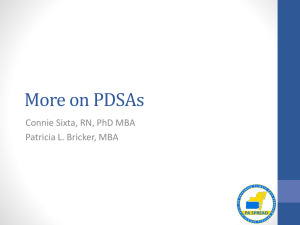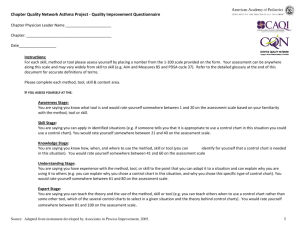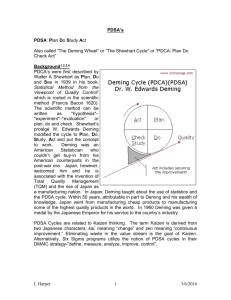Writing up improvement work for impact and
advertisement
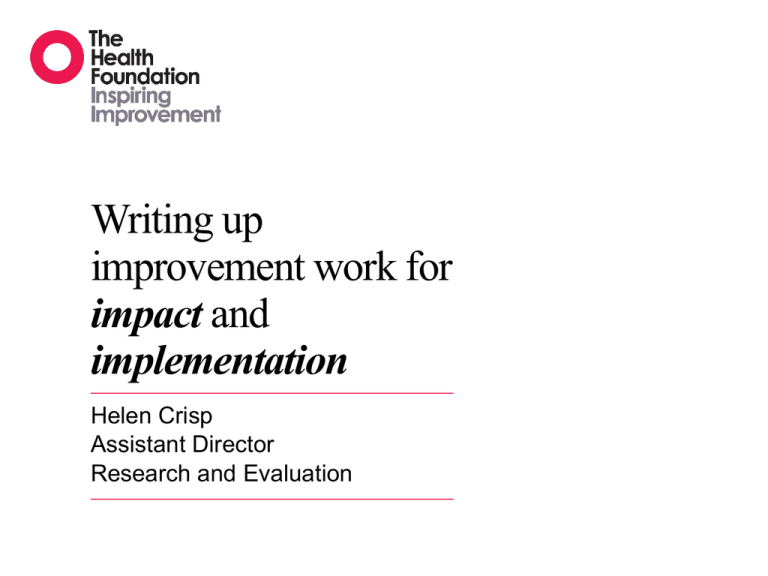
Writing up improvement work for impact and implementation Helen Crisp Assistant Director Research and Evaluation Reporting for impact and implementation Aim: To encourage better reporting of improvement work to encourage spread of successful approaches 2 Reporting for impact and implementation Why don’t we learn from improvement projects? Around the world 1,000s of improvement projects in healthcare: • Some make a difference • Others don’t work - but what do we learn from them? 3 Reporting for impact and implementation We could learn, if . . . Reports on improvement work told us not only the results but also: • how the initiative was designed • what were the core components • what measures and data were used to measure the change • what challenges were overcome along the way • how they were overcome • what the team would do differently in the future 4 Reporting for impact and implementation Part of the problem Many improvement reports amount to “See we did X!” versus “Here’s what we had to do to achieve X” Only your team (and possibly your parents) are interested in the first More people will care about the second 5 Reporting for impact and implementation Writing up for implementation Improvement reports need to provide enough detail: • to convey credibly that something worked • to give others insight on what they would have to do replicate in their clinical setting 6 Reporting for impact and implementation Common problems • Reports lack important details about key ingredients of intervention and institutional context − readers cannot know if it’s even worth pursuing • No barriers to implementation described − No improvement effort works immediately, this absence decreases credibility − Readers will ask “How did you get clinicians to do such and such?” Or “Did this newly designed tool really work right away?” 7 Reporting for impact and implementation Typical QI report Introduction Methods Hospital infections affect thousands each year Hospital staff do not wash their hands consistently We implemented a multifaceted strategy: • Staff education Briefly stated design, data collection strategy and main outcomes, plus some mention of PDSA • Clinical champions • Empowering patients to ask staff if they have washed their hands Results We improved hand hygiene by 50% Discussion Patient empowerment can be effective 8 Reporting for impact and implementation What is lacking here? Introduction Hospital infections affect thousands each year Hospital staff do not wash their hands consistently We implemented a multifaceted strategy: • Staff education No connection between the introduction material and specific features of the intervention • Clinical champions • Empowering patients to ask staff if they have washed their hands 9 Reporting for impact and implementation A better approach? Introduction Commonly identified barriers to hand hygiene compliance include A, B, and C Staff education, clinical champions, and empowering patients address A, B, and C by doing X, Y, and Z • • • This introduction makes clear what factors explain poor hand hygiene And, it makes explicit why the intervention includes these ingredients This “theory for the intervention” will pay off in writing the report and interpreting the results 10 Reporting for impact and implementation But what did you do??? Methods ‘PDSA’ is not fairy dust! Simply saying; ‘we carried out three PDSA cycles’ is not informative. What did the ‘study’ of what you had ‘done’ reveal and how did you ‘act’ as a result? Briefly stated design, data collection strategy and main outcomes, plus some mention of PDSA Results We improved hand hygiene by 50% Discussion Patient empowerment can be effective 11 Reporting for impact and implementation A better approach? Method After the first round of staff education we reviewed the delivery mechanism and feedback from participants, using PDSA methodology. It was reported that timing of training sessions was an issue in getting staff attendance, so the next sessions were planned with ward managers. Participants wanted more visual material to illustrate key points these were designed with staff and used in subsequent sessions. • This provides more detail which makes the report credible • Others are likely to have the same issues and could avoid making the same mistakes 12 Reporting for impact and implementation Points to consider • When do you start ‘writing up? • How to capture the key ingredients of your improvement initiative? • How do you set appropriate measures? • When barriers arise - how do you record these - and the action to overcome them? 13 Reporting for impact and implementation Some tips for writing up • Report writing always takes longer than you think – guard against leaving it to the last minute • Robust data collection and reporting from the outset is vital • Keeping an ‘improvement diary’ of the work helps to capture information at the time • Include different perspectives - not just the team leader, not just the clinical team • Patients, service users, commissioners, other departments/service providers will all have a view 14 Reporting for impact and implementation More tips for writing up • Consider the audience • While the core information is the same presentation differs for: • Accountability to the funder • A record for the team and organisation • Academic publication for researchers • Practitioners looking to adapt your ideas for local implementation • Beyond text: • Photos, videos, animation all bring the work to life more than text ever will 15 Reporting for impact and implementation A tool to help: SQUIRE Guidelines Standards for Quality Improvement Reporting Excellence Checklist of points to consider when writing up improvement work BUT Don’t leave it until you’ve completed the work Use guidelines to consider what data to capture as you go along Developed in 2008 and currently being revised 16 Disseminating and promoting your work 17 Reporting for impact and implementation Publication and beyond • Using SQUIRE or other guidelines will help to produce a coherent account • This improves chances of external publication • Approach a range of publications to target different audiences • Try to publish in the places professionals look to get ideas (not just high-impact peer reviewed journals) • Other approaches: • Web-sites and resource centres • National awards and competitions 18 Reporting for impact and implementation Awards – what the judges look for: • Clear results • Tangible benefits for patients (and staff) • Something a bit different – originality • Understanding what was done and how 19 Reporting for impact and implementation Spreading the word Professionals listen to their peers! Think of a range of approaches - and use every opportunity: • Blogs • Twitter • E-mail bulletins and: • Professional seminars • National and international conferences 20 Challenge: When you hear presentations on improvement projects - if it’s not clear how you would reproduce the work, ask: • More detail on the components? • What were the challenges along the way? • What sort of training for staff? • How did you engage the patients? • How did you use PDSA – what did change as a result? 21 For more information on Health Foundation funded improvement programmes see: www.health.org.uk SQUIRE Guidelines can be downloaded from: http://squire-statement.org/guidelines 22
